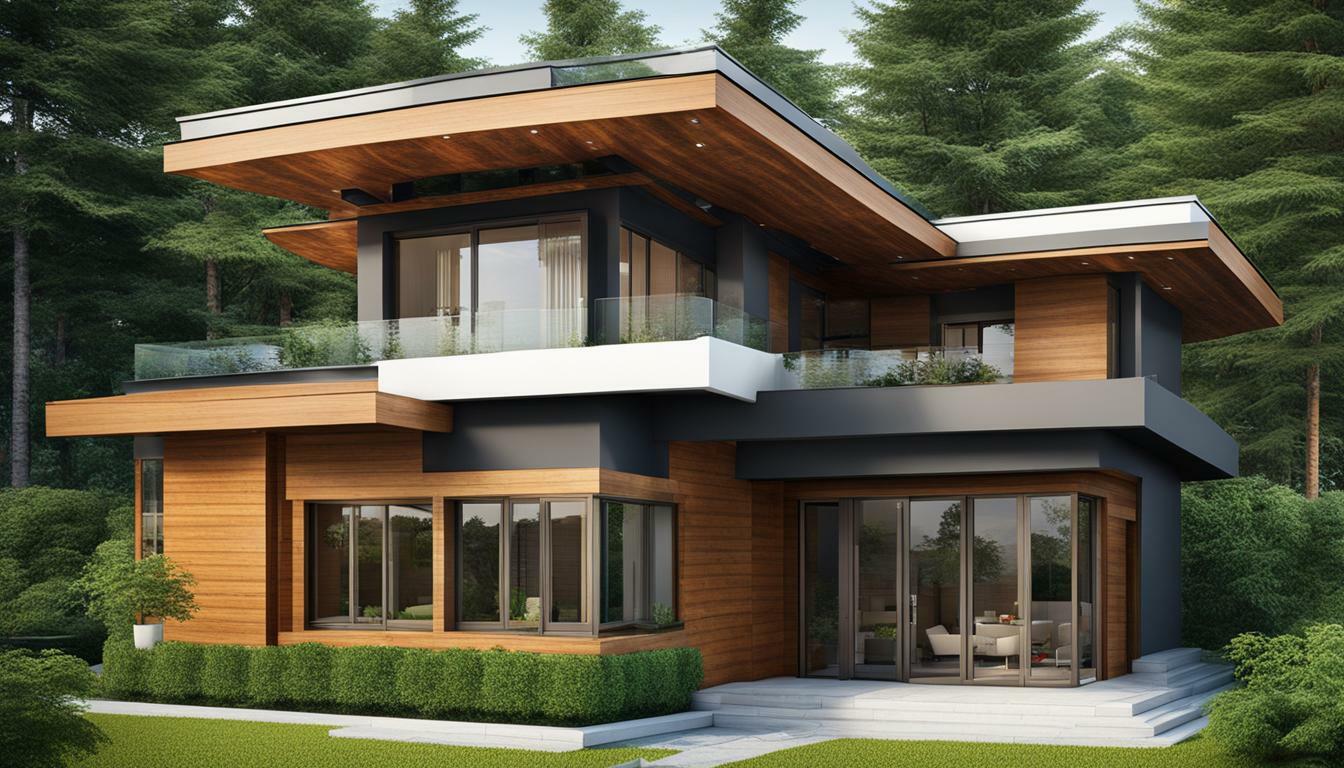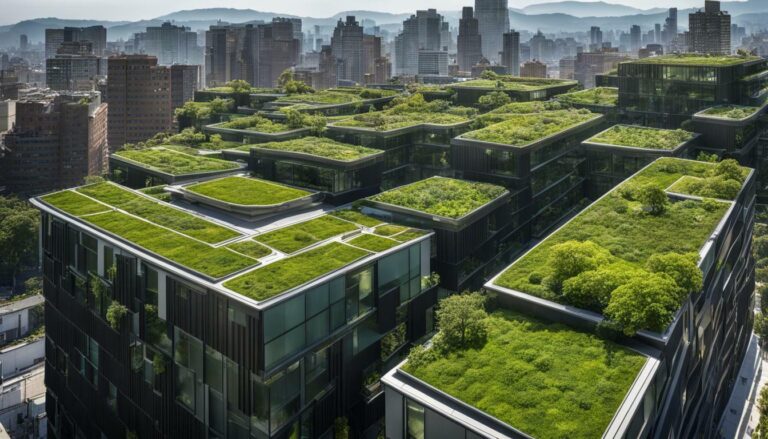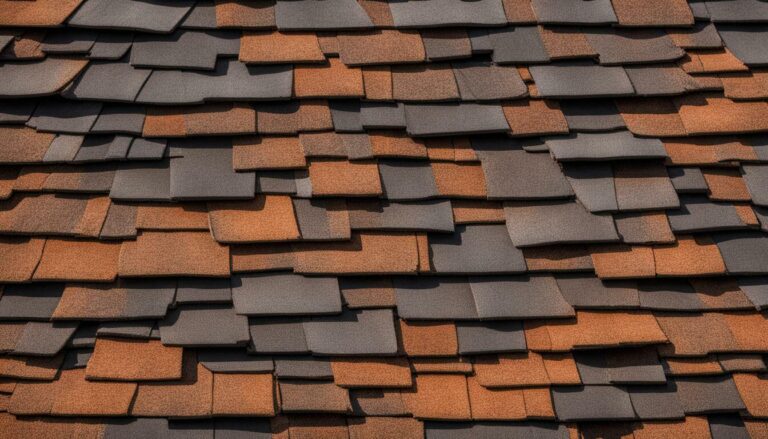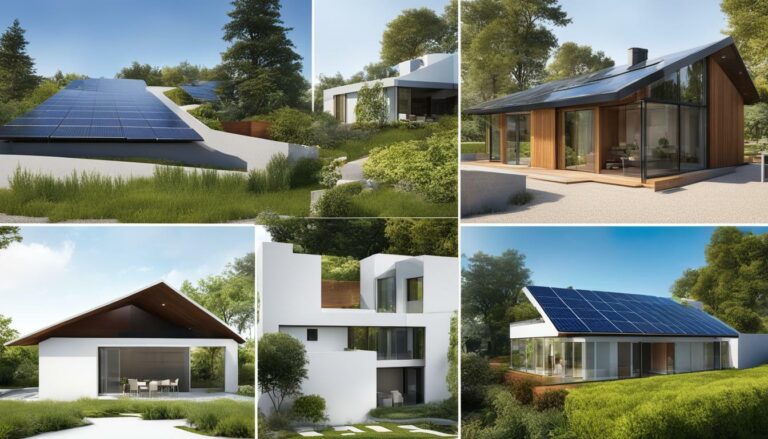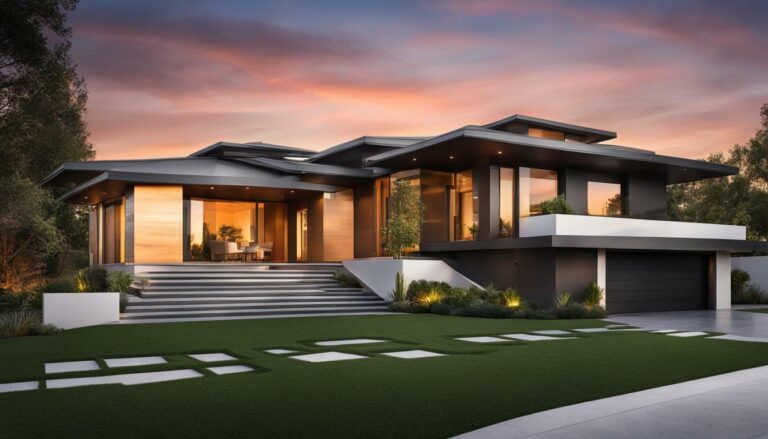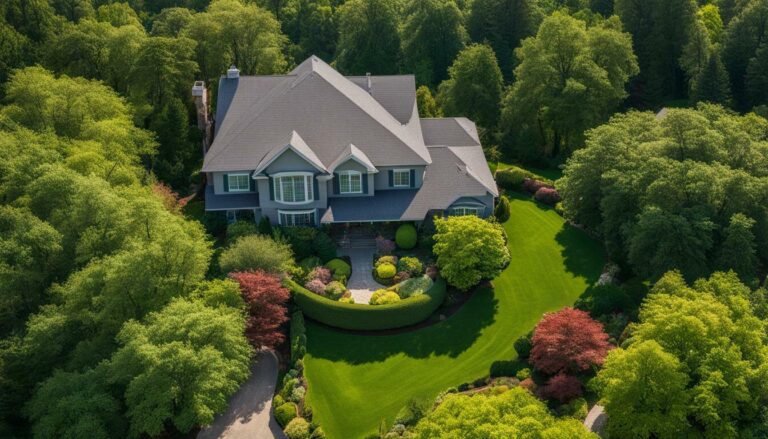Explore Recycled Roofing Options for Your Eco-Friendly Home
When it comes to creating an eco-friendly home, one of the key areas to consider is the roofing material you choose. By exploring recycled roofing options and selecting sustainable roof materials, you can not only reduce your environmental impact but also upgrade your lifestyle in a meaningful way.
By opting for recycled roofing options, you contribute to preserving the environment and minimizing waste. Sustainable roof materials offer a range of benefits, including energy efficiency, durability, and a classic or modern aesthetic appeal.
Key Takeaways:
- White or cool roofs reflect sunlight, reducing energy bills and the need for air conditioning.
- Standing-seam metal roofs made from recycled materials are durable, fire-resistant, and ideal for rainwater harvesting.
- Sustainable wood shakes provide a timeless and charming look to your home.
- Corrugated roofing is versatile and easy to fix, available in various styles and colors.
- Reclaimed slate or clay roofs offer natural beauty, durability, and the benefits of a cool roof system.
When selecting a roofing material, it’s crucial to involve experts or professionals with adequate skills and knowledge to ensure proper installation. Additionally, consider factors such as warranty, fire ratings, storm ratings, and building department approvals for your chosen roofing material.
Remember that in addition to recycled roofing options, other eco-friendly choices like solar roofing, metal roofing, green roofing, and clay tiles offer alternative solutions. Take into account regional climate and regulations when making your decision. Consult with professional roofing contractors to maximize the benefits of your chosen material and enjoy a sustainable, eco-friendly home.
Why Choose Recycled Roofing?
Choosing recycled roofing materials offers numerous benefits for the environment and your home, as these green roofing options provide environmentally friendly roofs while utilizing recycled roof products. By opting for recycled roofing, you contribute to reducing waste and minimizing the extraction of new raw materials, making a positive impact on the planet. In addition, recycled roof materials often exhibit similar or even superior performance compared to traditional roofing materials, ensuring a durable and long-lasting solution for your home.
One of the key advantages of using green roofing materials is their reduced environmental footprint. Recycled roof products help to conserve natural resources and energy by repurposing materials that would otherwise end up in landfills. This not only reduces the demand for new materials but also decreases the associated energy consumption and greenhouse gas emissions generated during the manufacturing process. By choosing recycled roofing, you actively contribute to a more sustainable future.
Furthermore, environmentally friendly roofs offer a range of practical benefits. Many recycled roof options, such as standing-seam metal roofs or shingle roofs made from recycled materials, boast exceptional durability, fire resistance, and weather resistance. These roofs can withstand harsh weather conditions, providing your home with reliable protection against the elements. Additionally, some recycled roofing materials, like clay or slate tiles, offer excellent insulation properties, helping to maintain a comfortable indoor temperature and potentially reducing energy costs.
When it comes to choosing the right recycled roofing material for your home, it’s essential to consider factors such as regional climate, building regulations, and your personal preferences. Consulting with professional roofing contractors can help you navigate through the various options and select the most suitable choice for your specific needs.
Recycled Roofing Options at a Glance
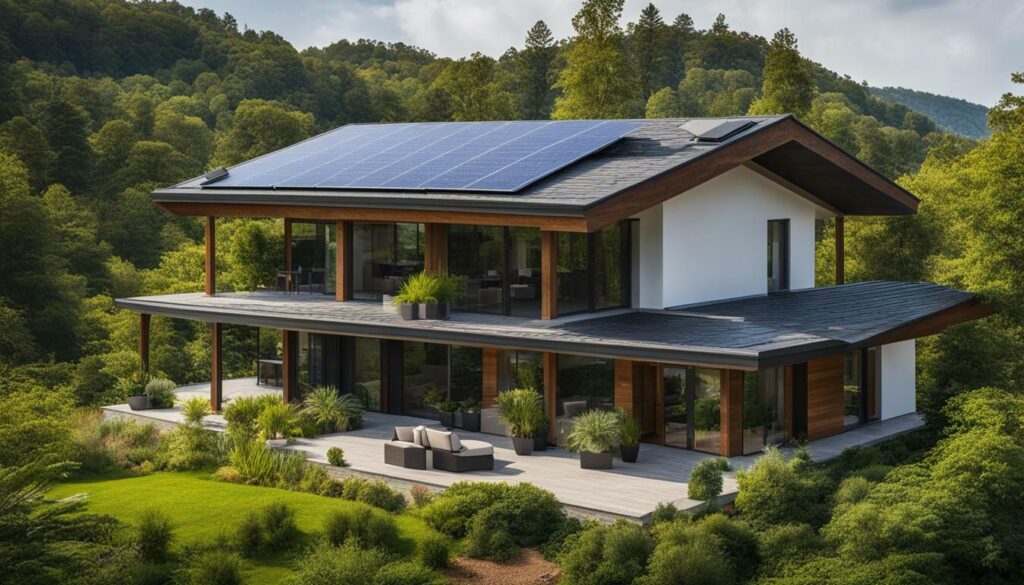
| Roofing Material | Benefits |
|---|---|
| White Roof or Cool Roof | Reflects sunlight, reduces energy bills, and lowers the need for air conditioning. |
| Standing-seam Metal Roofs | Made from recycled materials, offering durability, fire resistance, and rainwater harvesting potential. |
| Shingle Roof | Classic appearance with sustainable wood shakes sourced from well-managed forests. |
| Corrugated Roofing | Versatile, durable, and easy to repair, available in various colors and styles. |
| Reclaimed Slate or Clay Roof | Natural and long-lasting, clay and slate tiles can last up to 100 years and provide the benefits of a cool roof system. |
| Shingle Roof from Recycled Materials | Affordable and eco-friendly option made from recycled content, offering longevity. |
| Green Roof | Enhances insulation, reduces rainwater runoff, and improves the overall aesthetic appeal of the home. |
| Rubber Roofing | Made from old tires, rubber roofing is storm-resistant and can last up to 50 years. |
Make an informed decision by assessing the advantages and considerations of each recycled roofing option. Whether you prioritize energy efficiency, durability, or aesthetic appeal, there is a suitable choice to meet your needs. Remember, when selecting any roofing material, it is crucial to consult with experts or professionals who can provide guidance on the specific requirements and installation procedures.
Cool Roofs for Energy Efficiency
One eco-friendly roofing option to consider is a cool roof, such as a white roof, which can significantly improve energy efficiency in your home and reduce both energy bills and the reliance on air conditioning. Cool roofs are designed with light-colored surfaces that reflect sunlight, helping to keep the roof and the interior of your home cooler. This can be particularly beneficial in hot climates or during the summer months when cooling costs can skyrocket.
By reducing the amount of heat absorbed by your roof, a cool roof can help to reduce the need for air conditioning, resulting in lower energy bills and decreased carbon emissions. The reflective properties of a white roof can keep the surface temperature significantly lower than traditional dark-colored roofs, reducing heat transfer to the building below.
According to the U.S. Department of Energy, a cool roof can reduce the surface temperature of a roof by up to 50 degrees Fahrenheit, leading to a reduction in overall energy consumption and costs. Additionally, cool roofs can also extend the lifespan of your roof by reducing thermal expansion and contraction, which can cause damage over time.
Benefits of a Cool Roof:
| Benefits | Description |
|---|---|
| Energy Savings | A cool roof can reduce energy consumption and lower energy bills. |
| Environmental Impact | By reducing energy usage, cool roofs help to decrease carbon emissions and reduce the demand for fossil fuels. |
| Comfort | A cool roof can help to maintain a more comfortable indoor temperature by reducing heat transfer. |
| Durability | Cool roofs can extend the lifespan of your roof by reducing the expansion and contraction that can cause damage over time. |
When considering a cool roof for your home, it’s important to consult with a professional roofing contractor who can assess your specific needs and recommend the most suitable roofing material and design. They can also ensure that the cool roof is properly installed to maximize its energy-saving benefits. Additionally, be sure to check for any local regulations or incentives related to cool roofing options, as some areas may offer rebates or tax credits for installing energy-efficient roofing systems.

Overall, a cool roof can be a wise investment for both your wallet and the environment. By choosing a roofing option that reflects sunlight and reduces heat absorption, you can enjoy lower energy bills, enhanced comfort in your home, and a reduced carbon footprint. Consider the benefits of a cool roof when exploring eco-friendly roofing options for your home.
Durable and Sustainable: Standing-Seam Metal Roofs
For homeowners seeking a durable and sustainable roofing solution, standing-seam metal roofs made from recycled materials are an excellent choice, offering both long-lasting performance and positive environmental impact. These roofs are crafted from high-quality metal panels that interlock with raised seams, providing superior resistance against leaks, wind, and fire.
One of the key advantages of standing-seam metal roofs is their longevity. Built to withstand harsh weather conditions, these roofs can last up to 50 years or more with minimal maintenance. This durability reduces the need for frequent roof replacements, resulting in cost savings over time.
Moreover, standing-seam metal roofs are a sustainable option for eco-conscious homeowners. They are typically made from recycled materials, such as aluminum or steel, which lowers the demand for virgin resources. By choosing recycled metal roofing, you contribute to reducing waste and conserving natural resources.
| Benefits of Standing-Seam Metal Roofs | Environmental Impact |
|---|---|
| Longevity: Lasts up to 50 years or more | Uses recycled materials, reducing demand for virgin resources |
| Fire Resistance: Provides excellent fire protection | Reduces landfill waste by using recycled metal |
| Energy Efficiency: Reflects sunlight, reducing cooling costs | Lower carbon footprint compared to traditional roofing materials |
Additionally, standing-seam metal roofs offer energy-saving benefits. With their reflective surfaces, they help to minimize heat absorption and reduce cooling costs during hot summers. This energy efficiency not only saves you money on utility bills but also lowers your carbon footprint by reducing the need for air conditioning.
To make the most of sustainable roofing options like standing-seam metal roofs, it is crucial to consult with professional roofing contractors who specialize in eco-friendly installations. They can guide you through the selection process, ensuring that the chosen material meets your specific needs and complies with local building codes.
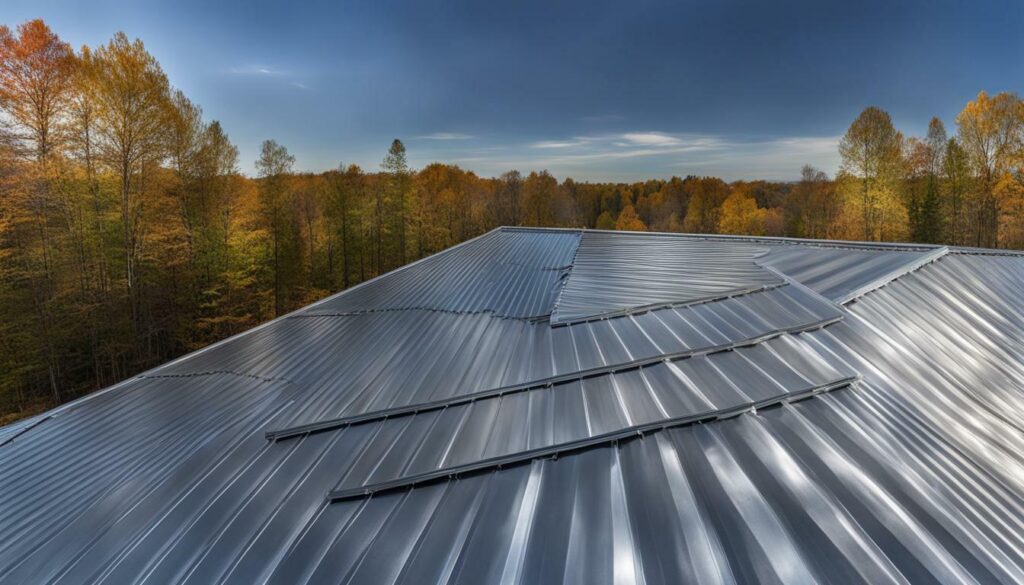
In conclusion, standing-seam metal roofs made from recycled materials offer a durable and sustainable choice for homeowners. With their long lifespan, fire resistance, energy efficiency, and positive environmental impact, these roofs provide a smart investment for both your home and the planet. Consider consulting with roofing professionals to explore the best eco-friendly options and enjoy the benefits of a sustainable roofing system.
Classic Appearance with Sustainable Wood Shakes
If you appreciate the timeless appeal of a shingle roof, consider sustainable wood shakes made from responsibly sourced wood that adds a classic and eco-friendly touch to your home. Wood shakes are carefully crafted from natural materials, providing a unique and rustic appearance that complements various architectural styles. These shakes are an excellent choice for homeowners who value sustainability and want to make an environmentally friendly statement.
One of the key advantages of sustainable wood shakes is their durability. Made from high-quality wood, such as cedar or redwood, these shakes can withstand harsh weather conditions, including strong winds, heavy rain, and intense sunlight. When properly installed and maintained, wood shakes can last for several decades, making them a long-term investment for your home.
Not only do sustainable wood shakes enhance the aesthetic appeal of your home, but they also offer excellent insulation properties. The natural composition of wood helps to regulate temperature, keeping your home cooler in the summer and warmer in the winter. This can result in energy savings and reduced reliance on heating and cooling systems, making wood shakes an eco-friendly choice that supports energy efficiency.
| Benefits of Sustainable Wood Shakes: |
|---|
| 1. Classic and timeless appearance |
| 2. Durability and resistance to harsh weather conditions |
| 3. Excellent insulation properties |
| 4. Environmentally friendly and sustainable |
To ensure the longevity and performance of sustainable wood shakes, proper installation and maintenance are crucial. It is essential to work with experienced roofing professionals who have expertise in installing wood shakes. Regular inspections and treatments can help prevent issues such as moss or fungi growth, ensuring the shakes remain in optimal condition for years to come.
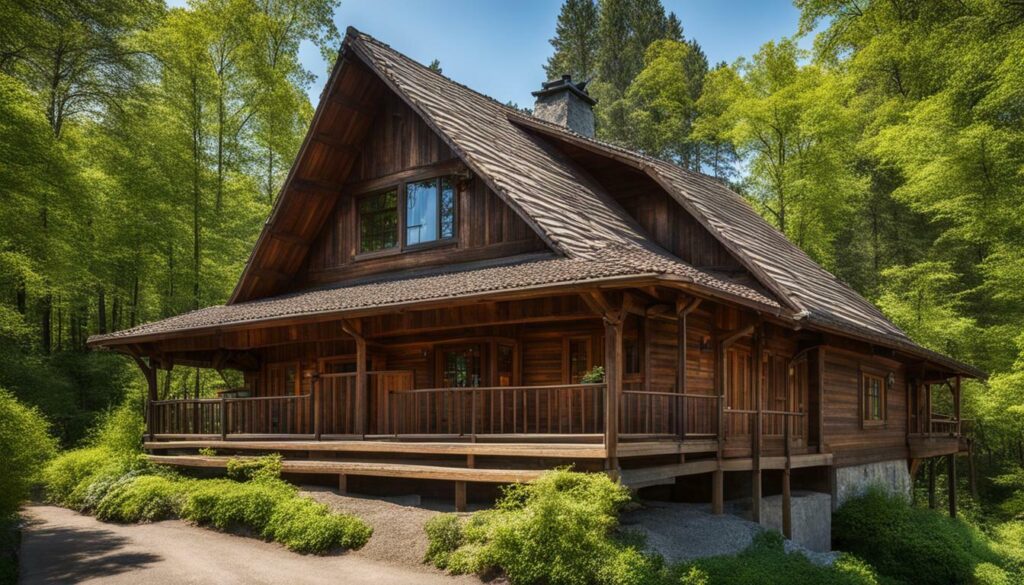
When choosing sustainable wood shakes for your roof, be sure to select products sourced from responsibly managed forests. Look for certifications such as Forest Stewardship Council (FSC) to ensure that the wood comes from sustainable and renewable sources. By opting for responsibly sourced wood shakes, you are making an environmentally conscious decision that promotes the preservation of forests and ecosystems.
Embrace the beauty and sustainability of wood shakes for your roofing needs. With their classic appearance and eco-friendly qualities, sustainable wood shakes can enhance the overall aesthetic of your home while minimizing your environmental impact.
Versatile and Easy to Fix: Corrugated Roofing
When it comes to versatility and ease of maintenance, corrugated roofing stands out as an excellent option for homeowners looking for a practical and eco-friendly solution. Made from durable materials such as metal or fiberglass, corrugated roofs offer numerous benefits that make them a popular choice in sustainable roofing options.
One of the key advantages of corrugated roofing is its versatility. With various colors and styles available, homeowners can find the perfect match for their home’s aesthetic. Whether you prefer a traditional or modern look, corrugated roofing can provide a seamless blend with your overall design.
Not only is corrugated roofing visually appealing, but it is also easy to maintain. The corrugated design allows for efficient water drainage, preventing the buildup of debris and reducing the risk of leaks. In the event of damage, repairs are straightforward and cost-effective, as individual panels can be easily replaced without disrupting the entire roof.
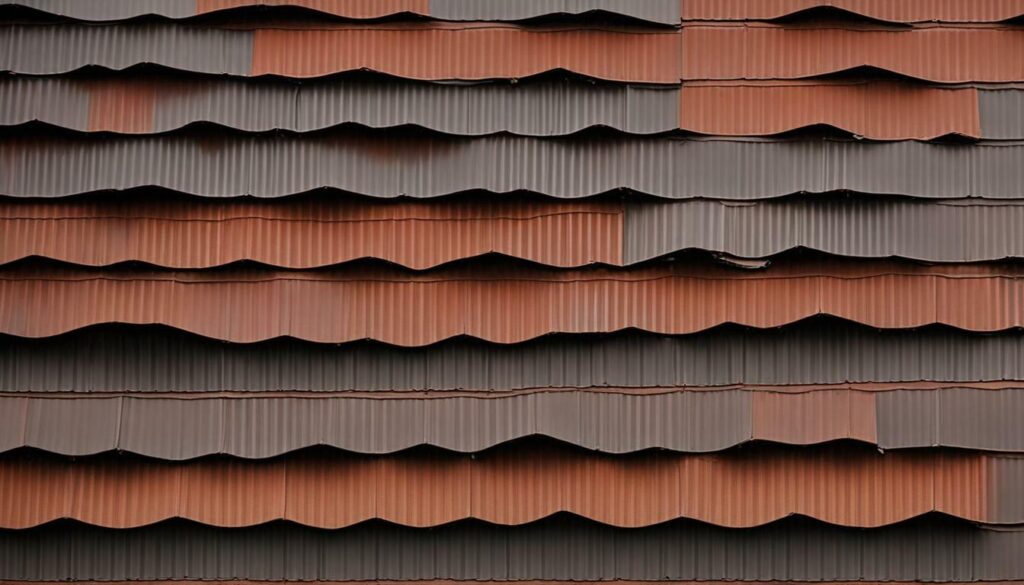
The Benefits of Corrugated Roofing:
| Advantages | Details |
|---|---|
| 1. Durability | Corrugated roofing is resistant to harsh weather conditions, such as strong winds and heavy rain, making it a reliable and long-lasting choice. |
| 2. Eco-Friendly | Many corrugated roofing materials are made from recycled content, reducing the environmental impact and promoting sustainability. |
| 3. Lightweight | Compared to other roofing materials, corrugated roofs are lightweight, reducing the strain on the structure of your home. |
| 4. Cost-Effective | Corrugated roofing is affordable, making it an economical choice for homeowners looking to enhance their homes without breaking the bank. |
When considering roofing options for your eco-friendly home, it’s important to weigh the benefits and drawbacks of each choice. Corrugated roofing offers versatility, easy maintenance, durability, and affordability, making it a top choice for practical and environmentally conscious homeowners. Consult with professional roofing contractors to ensure proper installation and to maximize the benefits of this versatile roofing solution.
Natural and Long-Lasting: Reclaimed Slate or Clay Roof
For a sustainable roofing solution that combines natural beauty with exceptional longevity, consider the timeless elegance of reclaimed slate or clay roofs, perfect for creating a lasting impact on your eco-friendly home. Reclaimed slate and clay tiles offer a durable and environmentally friendly option that adds character and charm to any property.
Slate and clay roofs have a lifespan of up to 100 years, making them an excellent long-term investment. These natural materials are known for their durability and ability to withstand harsh weather conditions. Whether you choose reclaimed slate with its rustic appeal or clay tiles with their classic look, both options provide exceptional protection for your home.
One of the key benefits of reclaimed slate and clay roofs is their ability to keep your home cool. The light-colored clay tiles, in particular, are highly reflective and help to reduce heat absorption, resulting in lower energy costs. By opting for a cool roof system, you not only benefit from increased energy efficiency but also contribute to a more sustainable future.
| Benefits of Reclaimed Slate and Clay Roofs |
|---|
| 1. Exceptional longevity, with a lifespan of up to 100 years. |
| 2. Natural beauty and timeless elegance. |
| 3. High durability and resistance to harsh weather conditions. |
| 4. Cool roof system, reducing heat absorption and energy costs. |
When considering reclaimed slate or clay roofs, it’s important to work with professional roofing contractors who have experience in installing these materials. They can provide guidance on selecting the right type of tiles, ensuring proper installation, and maximizing the benefits of your chosen roofing material.
Investing in a reclaimed slate or clay roof not only enhances the visual appeal of your home but also showcases your commitment to sustainability. By choosing natural and durable materials, you can create a beautiful and eco-friendly living space that will stand the test of time.
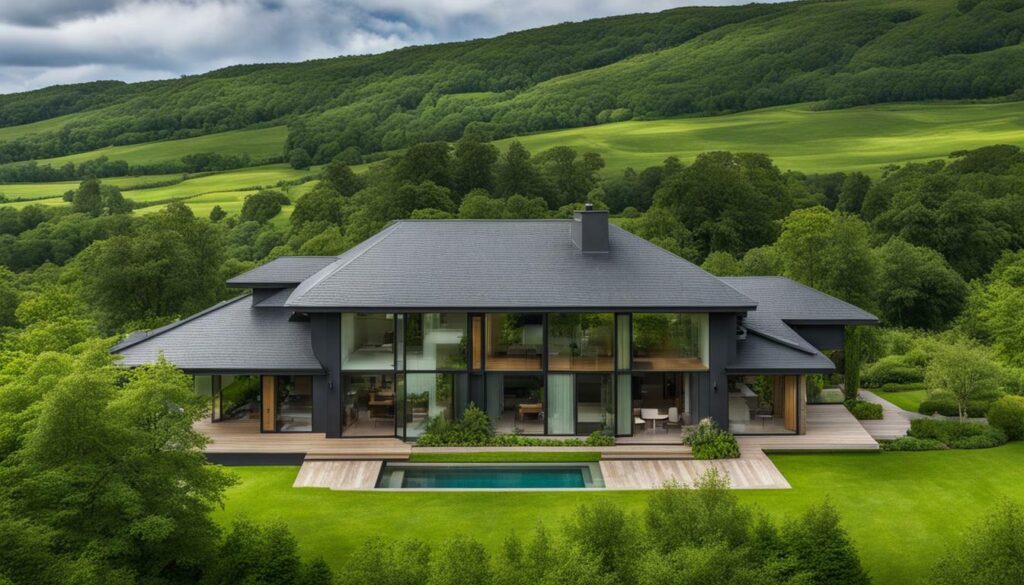
If cost-effectiveness and environmental impact matter to you, opting for a shingle roof made from recycled materials, such as plastic and wood fiber, provides an affordable and durable solution that lasts for decades. These shingles are not only budget-friendly but also contribute to reducing waste and promoting sustainability.
Recycled shingle roofs offer several advantages. Firstly, they are made from post-consumer waste, which reduces the demand for new materials and lowers the carbon footprint associated with traditional manufacturing processes. By repurposing materials that would otherwise end up in landfills, you are actively participating in the circular economy and supporting a greener future.
Secondly, shingle roofs made from recycled materials are designed to withstand harsh weather conditions, providing long-lasting protection for your home. They offer exceptional durability and resistance to UV rays, moisture, and pests, ensuring that your investment stands the test of time. With a lifespan of over 50 years, these shingles require minimal maintenance and can withstand the elements without compromising their performance.
When choosing a shingle roof from recycled materials, it is important to consider various factors. Look for products that are certified by recognized organizations, such as the Forest Stewardship Council (FSC), to ensure that they meet stringent environmental and sustainability standards. Additionally, consult with a professional roofing contractor who has experience installing recycled shingles to ensure proper installation and maximize the benefits of this eco-friendly option.
Tables Showing Comparison of Recycled Shingle Roof Costs
| Shingle Material | Cost per Square Foot (including installation) |
|---|---|
| Recycled Plastic and Wood Fiber | $3.50 – $5.50 |
| Traditional Asphalt | $2.50 – $4.50 |
| Metal | $7.00 – $12.00 |
Table 1: Comparison of costs per square foot for different shingle materials, including installation. Prices may vary based on location and roofing contractor.
As shown in Table 1, recycled shingles are competitively priced compared to traditional asphalt shingles and offer a more environmentally friendly alternative. While metal roofs may provide superior longevity, they come at a higher cost. Therefore, if affordability and sustainability are key considerations for your roofing project, choosing shingle roofs made from recycled materials is a smart choice.
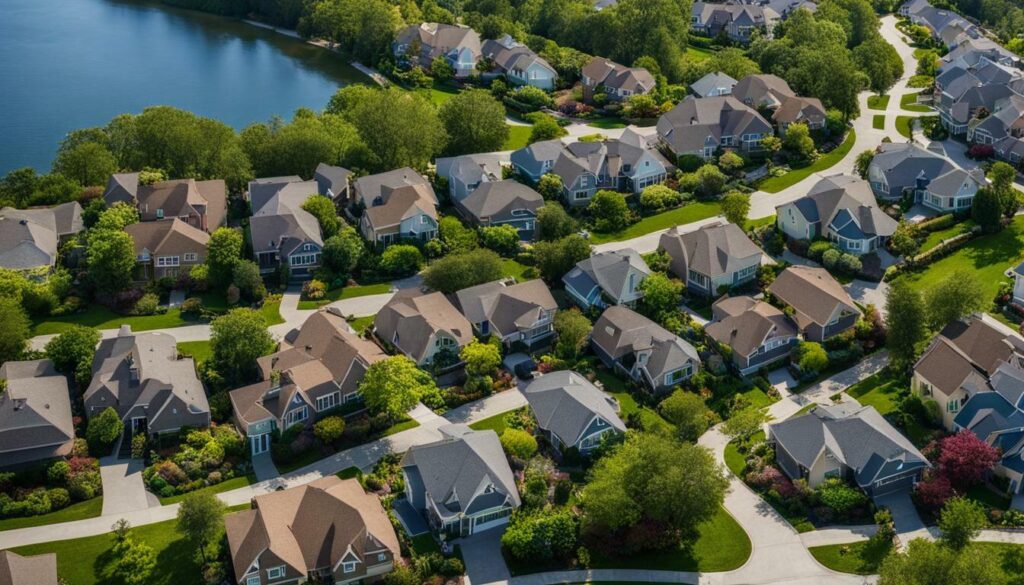
Enhance Your Home with a Green Roof
Transforming your roof into a living space by incorporating a green roof can provide insulation, mitigate rainwater runoff, and elevate the aesthetics of your eco-friendly home. A green roof, also known as a living roof or vegetated roof, consists of a layer of vegetation planted on top of a traditional roofing system. This innovative approach to roofing offers numerous benefits for both homeowners and the environment.
One of the key advantages of a green roof is its ability to provide insulation. The vegetation layer acts as a natural barrier, reducing heat transfer between the roof and the interior of your home. This helps to regulate indoor temperature, resulting in energy savings and decreased reliance on HVAC systems. In fact, studies have shown that green roofs can reduce cooling energy consumption by up to 75% during peak summer months.
Another significant benefit of incorporating a green roof is its ability to mitigate rainwater runoff. The vegetation layer absorbs and retains rainwater, preventing it from flowing directly into stormwater drains. This not only helps to alleviate the burden on municipal drainage systems but also reduces the risk of flooding in urban areas. Additionally, the plants on the green roof naturally filter rainwater, improving its quality as it enters the environment.

Aside from their functional advantages, green roofs also enhance the overall aesthetics of your home. The lush vegetation adds a touch of natural beauty to your property, creating a harmonious connection with the surrounding environment. Whether you opt for a simple sedum roof or a more elaborate rooftop garden, a green roof can transform an ordinary roof into a stunning visual feature.
Incorporating a green roof into your eco-friendly home is a decision that brings multiple benefits, from insulation and rainwater management to aesthetics. However, it is important to consider the specific requirements and limitations of your property before proceeding. Consult with professional roofing contractors who specialize in green roofs to ensure proper installation and maximize the benefits of this sustainable roofing option.
Conclusion
Making environmentally conscious choices, such as opting for recycled roofing options, is a crucial step in creating an eco-friendly home. Additionally, considering other sustainable roofing choices like solar roofing, metal roofing, and clay tiles can further enhance the environmental impact of your home. A consultation with professional roofing contractors ensures proper installation and maximizes the benefits of the chosen material.
When exploring roofing options for an eco-friendly home, there are several choices to consider. Some of the top options include:
- White Roof or Cool Roof: These roofs have a light color that reflects sunlight, helping to reduce energy bills and the need for air conditioning.
- Standing-seam Metal Roofs: Made from recycled materials, metal roofs are durable, fire-resistant, and can last up to 50 years. They are also ideal for harvesting rainwater and preventing ice dams.
- Shingle Roof: Sustainable wood shakes from well-managed forests offer a classic appearance.
- Corrugated Roofing: Durable and versatile, corrugated roofing comes in various colors and styles and is easy to fix.
- Reclaimed Slate or Clay Roof: Clay and slate tiles are natural and durable, with a lifespan of up to 100 years. Light-colored clay tiles offer the benefits of a cool roof system.
- Shingle Roof from Recycled Materials: Made from recycled content such as plastic and wood fiber, these shingles are affordable and can last over 50 years.
- Green Roof: By planting vegetation on the roof, green roofs offer insulation, reduce rainwater runoff, and enhance the home’s appearance.
- Rubber Roofing: Made from old tires, rubber roofing is storm-resistant and can last up to 50 years.
Considerations for homeowners:
- Roofing should be done by experts or with adequate skills and knowledge.
- Compare eco-friendly roofing options carefully, considering factors such as warranty, fire ratings, and storm ratings.
- Ensure that the selected roof material is approved by the building department before purchasing.
- Some materials may require additional structural support.
In addition to recycled roofing options, other eco-friendly choices include solar roofing, metal roofing, green roofing, and clay tiles. Consider regional climate and regulations when making a choice. Recycled shingles are the cheapest option, while clay tiles are the longest-lasting. Consult with professional roofing contractors to ensure proper installation and maximize the benefits of the chosen material.
FAQ
Q: Why should I choose recycled roofing?
A: Recycled roofing offers several benefits, including reducing environmental impact and promoting sustainability. Using recycled materials helps conserve natural resources and reduces waste. It also contributes to creating an eco-friendly home and supports green building practices.
Q: What are the advantages of cool roofs?
A: Cool roofs, such as white roofs or cool roofs with light-colored surfaces, reflect sunlight and reduce the amount of heat absorbed by your home. This can help lower energy bills by reducing the need for air conditioning. Cool roofs also help mitigate the heat island effect in urban areas and contribute to a more comfortable indoor environment.
Q: Are standing-seam metal roofs a sustainable choice?
A: Yes, standing-seam metal roofs are a sustainable choice for several reasons. They are made from recycled materials, such as steel or aluminum, which helps reduce waste and conserve resources. Metal roofs are also durable, fire-resistant, and can last up to 50 years, reducing the need for frequent replacements. Additionally, they are ideal for rainwater harvesting and can help prevent ice dams.
Q: What are the advantages of shingle roofs made from sustainable wood shakes?
A: Shingle roofs made from sustainable wood shakes offer a classic appearance and contribute to a natural aesthetic. These wood shakes are sourced from well-managed forests, ensuring responsible forestry practices. They are also durable and can provide insulation for your home.
Q: Are corrugated roofs easy to repair?
A: Yes, corrugated roofing is relatively easy to fix. In case of damage, individual sheets can be replaced without requiring an entire roof replacement. Corrugated roofing also comes in various colors and styles, offering versatility in design options.
Q: How long do reclaimed slate or clay roofs last?
A: Reclaimed slate or clay roofs can last up to 100 years, making them a long-lasting and sustainable choice. These natural materials provide durability and have a classic appeal. Light-colored clay tiles can also offer the benefits of a cool roof system.
Q: What are the advantages of shingle roofs made from recycled materials?
A: Shingle roofs made from recycled materials, such as plastic and wood fiber, are affordable and eco-friendly. These shingles are designed to mimic the appearance of traditional roofing materials while reducing waste. They can last over 50 years, making them a durable choice for an eco-friendly home.
Q: What are the benefits of a green roof?
A: Green roofs, which involve planting vegetation on the roof, offer several benefits. They provide insulation for your home, reducing energy consumption for heating and cooling. Green roofs also help reduce rainwater runoff by absorbing and retaining water, reducing the strain on stormwater systems. Additionally, they enhance the overall appearance of your home and provide habitat for wildlife.
Q: Are rubber roofs a sustainable option?
A: Rubber roofing, made from recycled tires, is a sustainable choice. It helps divert waste from landfills and promotes recycling. Rubber roofs are also storm-resistant and can last up to 50 years, offering durability and longevity.
